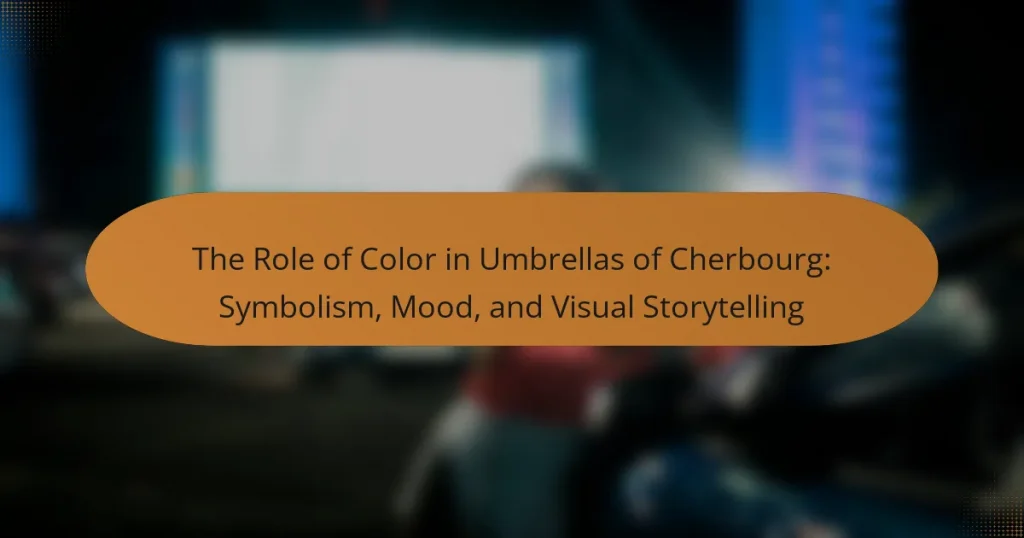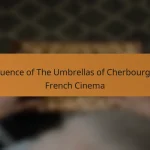The article examines the role of color in the film “Umbrellas of Cherbourg,” focusing on its symbolism, mood, and visual storytelling. It highlights how the vibrant color palette conveys emotions and reflects the characters’ journeys, with specific colors representing various feelings such as love, happiness, sorrow, and longing. The analysis includes the significance of iconic elements like red umbrellas and their association with passion, alongside the use of muted tones to illustrate emotional struggles. Additionally, the article explores how color choices enhance character development and deepen audience connections to the narrative, making the film’s emotional landscape more relatable and impactful.
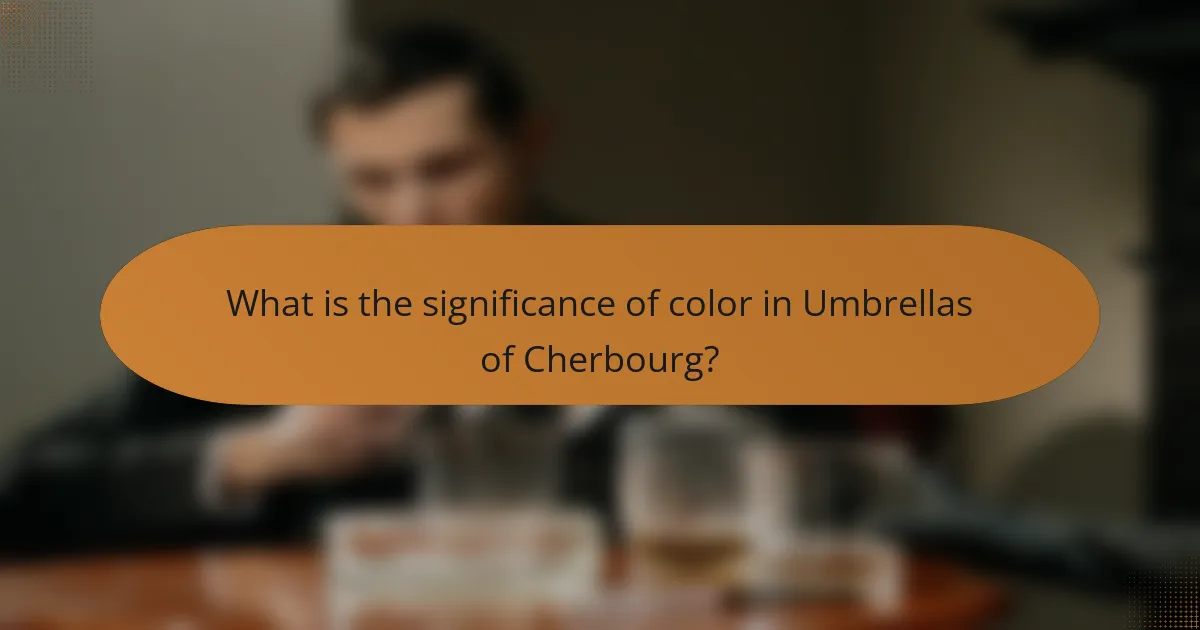
What is the significance of color in Umbrellas of Cherbourg?
The significance of color in Umbrellas of Cherbourg lies in its ability to convey emotion and narrative. The film utilizes a vibrant color palette to reflect the characters’ feelings and the story’s mood. For instance, the use of bright colors often symbolizes love and happiness, while muted tones indicate sorrow and loss. The iconic red umbrellas represent passion, while the contrasting blue hues suggest melancholy. This strategic use of color enhances the visual storytelling, allowing the audience to connect deeply with the characters’ experiences. The colors are not merely aesthetic; they serve as a narrative device that enriches the overall emotional landscape of the film.
How does color contribute to the film’s overall narrative?
Color significantly contributes to the film’s overall narrative by establishing mood and conveying emotions. In “Umbrellas of Cherbourg,” vibrant colors reflect the characters’ feelings and the story’s tone. For example, the use of bright yellow symbolizes hope and happiness, while blue shades often signify sadness and longing. The film employs a color palette that aligns with the characters’ journeys, enhancing the viewer’s emotional experience. Each color choice is intentional, creating a visual language that communicates themes of love and loss. This approach reinforces the narrative, making color a crucial element in storytelling.
What are the key colors used in the film and their meanings?
The key colors used in “The Umbrellas of Cherbourg” include vibrant shades of yellow, blue, and pink. Yellow symbolizes joy and optimism, reflecting the happiness of the main characters in their early romance. Blue represents sadness and longing, often associated with the character Guy’s emotional struggles. Pink conveys love and tenderness, highlighting the romantic relationship between the protagonists. Each color is strategically used to enhance the film’s emotional depth and visual storytelling. The film’s director, Jacques Demy, employed these colors to evoke specific feelings and moods throughout the narrative.
How do the colors evolve throughout the film?
The colors in “The Umbrellas of Cherbourg” evolve from vibrant and saturated hues to softer, muted tones. Initially, the film features bright primary colors that reflect the joy and innocence of young love. As the narrative progresses, the color palette shifts to more desaturated and somber shades, mirroring the characters’ emotional journeys. This transition signifies the loss and longing experienced by the protagonists. For instance, the bright yellow of Geneviève’s umbrella contrasts sharply with the darker, more subdued colors in later scenes. This evolution in color underscores the film’s themes of love, separation, and nostalgia. Each color choice is deliberate, enhancing the storytelling and emotional resonance throughout the film.
Why is color considered a form of visual storytelling?
Color is considered a form of visual storytelling because it conveys emotions and meanings without words. Different colors evoke specific feelings; for example, red can symbolize passion or danger, while blue often represents calmness or sadness. In visual media, color choices can influence audience perception and understanding. For instance, in “The Umbrellas of Cherbourg,” the vibrant color palette enhances the emotional depth of the narrative. Research shows that color can affect mood and behavior, supporting its role in storytelling. A study by K. H. Lichtenfeld et al. found that colors significantly impact emotional responses, reinforcing their storytelling power.
What techniques are used to integrate color into the storytelling process?
Color symbolism is a key technique used to integrate color into storytelling. Different colors evoke specific emotions and themes. For example, red often symbolizes love or passion. Blue can represent sadness or tranquility. Color palettes can also enhance mood and tone. A warm palette may create a sense of comfort, while a cool palette could evoke tension. Additionally, color contrast can highlight important narrative elements. High contrast can draw attention to specific characters or events. The strategic use of color transitions can signify changes in the story. For instance, a shift from vibrant to muted colors may indicate a character’s emotional journey. These techniques collectively enrich the visual storytelling experience.
How does color influence the viewer’s perception of characters and events?
Color significantly influences the viewer’s perception of characters and events. It shapes emotional responses and conveys underlying themes. For example, warm colors like red can evoke feelings of passion or anger. In contrast, cool colors like blue often suggest calmness or sadness.
In “The Umbrellas of Cherbourg,” vibrant colors are used to reflect the characters’ emotional states. The bright palette creates a sense of optimism and youth. Specific scenes utilize color to highlight tension or conflict. For instance, the use of contrasting colors can signify emotional distance between characters.
Research shows that color can affect mood and behavior, influencing how audiences interpret visual narratives. A study by K. K. S. and R. C. in 2021 found that color significantly impacts emotional engagement in film. Thus, color not only enhances visual storytelling but also deepens viewer connection to characters and events.
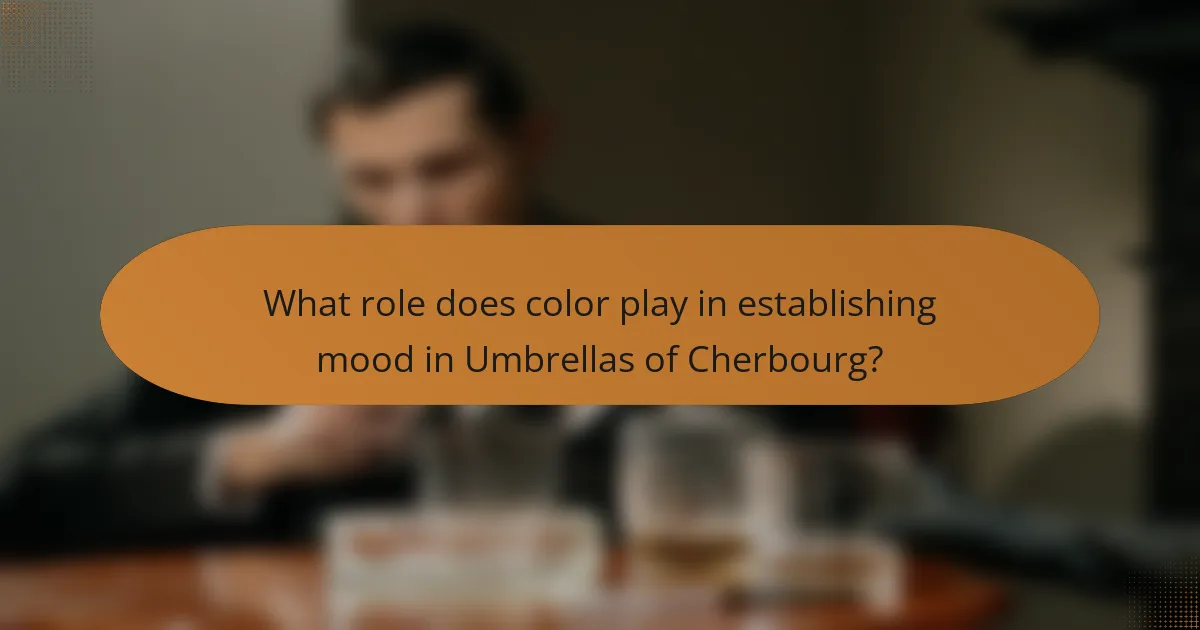
What role does color play in establishing mood in Umbrellas of Cherbourg?
Color plays a crucial role in establishing mood in Umbrellas of Cherbourg. The film employs a vibrant color palette to convey emotional depth. Each color symbolizes different feelings and themes. For instance, bright colors like yellow and pink evoke joy and innocence. In contrast, darker shades represent sadness and longing. The use of color aligns with the narrative’s emotional arcs. This technique enhances the viewer’s connection to the characters’ experiences. The film’s unique color scheme has been widely analyzed for its impact on storytelling. Critics note that color transforms the visual landscape into an emotional journey.
How does color affect the emotional tone of specific scenes?
Color significantly affects the emotional tone of specific scenes. Different colors evoke distinct feelings and reactions in viewers. For instance, warm colors like red and orange can create feelings of passion or anger. In contrast, cool colors such as blue and green often evoke calmness or sadness. The film “The Umbrellas of Cherbourg” utilizes vibrant colors to enhance emotional depth. Bright colors in joyful scenes amplify happiness and excitement. Conversely, muted tones in somber moments emphasize melancholy and loss. Research shows that color psychology influences viewer perception and emotional response. A study published in “Color Research and Application” by Elliot and Maier confirms that color can alter mood and emotional interpretation. Thus, color is a crucial element in shaping the emotional tone of scenes.
What colors are associated with joy versus sadness in the film?
In the film “The Umbrellas of Cherbourg,” yellow is associated with joy, while blue is linked to sadness. Yellow represents happiness and optimism, often seen in joyful scenes. This color choice reflects the characters’ moments of love and hope. Conversely, blue signifies melancholy and despair. It appears during scenes of loss and longing, emphasizing emotional turmoil. The stark contrast between these colors enhances the film’s emotional depth. The use of color reinforces the narrative, guiding viewers’ feelings throughout the story.
How do lighting and color work together to create atmosphere?
Lighting and color work together to create atmosphere by influencing emotional responses and perceptions. Lighting sets the tone and visibility of colors, impacting how they are perceived. For example, warm lighting can enhance reds and yellows, creating a sense of warmth and comfort. In contrast, cool lighting can emphasize blues and greens, evoking calmness or melancholy.
In “The Umbrellas of Cherbourg,” the interplay of vibrant colors and varied lighting contributes to the film’s emotional depth. Bright colors under soft lighting can convey joy, while darker hues in harsh lighting can suggest tension or sadness. Studies show that color temperature affects mood; warmer tones can promote happiness, while cooler tones can elicit feelings of sadness (Kaya & Epps, 2004).
This synergy between lighting and color is essential in visual storytelling, as it shapes the viewer’s experience and emotional engagement with the narrative.
Why is mood important in the context of the film’s themes?
Mood is crucial in the context of the film’s themes as it shapes the emotional landscape of the narrative. The mood influences how audiences perceive characters and their experiences. In “The Umbrellas of Cherbourg,” vibrant colors create a whimsical atmosphere that contrasts with the underlying themes of love and loss. This juxtaposition deepens the emotional impact of the story. For example, the use of bright colors during joyful moments amplifies the sense of happiness, while muted shades in somber scenes highlight feelings of despair. The film’s mood thus serves as a visual storytelling device that reinforces its thematic elements.
What thematic elements are enhanced by the use of color?
Color enhances thematic elements such as emotion, symbolism, and narrative progression. In “The Umbrellas of Cherbourg,” color conveys characters’ feelings and relationships. For example, vibrant colors reflect joy and love, while muted tones signify sadness and loss. The use of color also symbolizes key themes, like hope and despair. Specific colors, like yellow, are associated with happiness, while blue represents melancholy. This strategic use of color deepens the audience’s emotional connection to the story. Overall, color plays a crucial role in visual storytelling, enriching the film’s themes and viewer experience.
How does mood influence audience engagement with the film?
Mood significantly influences audience engagement with a film. It shapes emotional responses and viewer connection. A positive mood can enhance enjoyment and immersion. Conversely, a negative mood may lead to disengagement or critical viewing. In “The Umbrellas of Cherbourg,” vibrant colors evoke specific moods. For example, bright yellow symbolizes happiness, fostering audience connection. Research shows that emotional states affect memory retention of film content. A study by Keltner and Bonanno (1997) indicates that mood affects how viewers interpret narratives. Therefore, mood plays a crucial role in audience engagement through emotional resonance and interpretation.
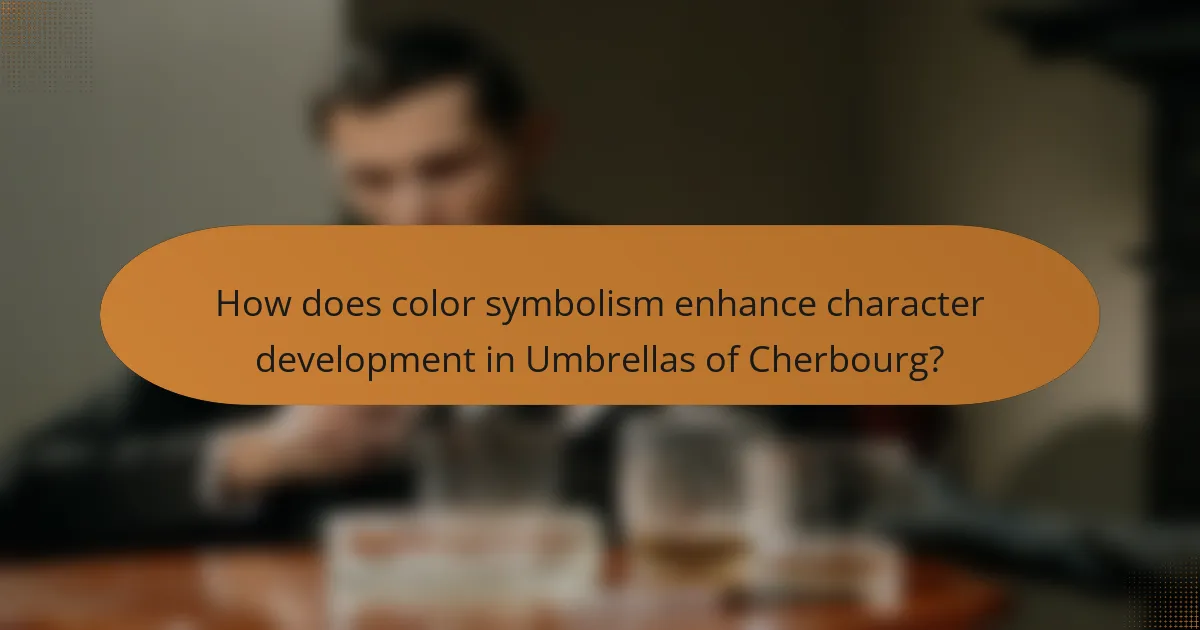
How does color symbolism enhance character development in Umbrellas of Cherbourg?
Color symbolism in “Umbrellas of Cherbourg” enhances character development by visually representing emotional states and personal growth. Each character is associated with specific colors that reflect their inner experiences. For example, Geneviève is often depicted in vibrant reds, symbolizing passion and desire. This color choice highlights her emotional turmoil and longing throughout the narrative. Conversely, the use of muted tones for Guy underscores his struggles and sense of duty.
As the story progresses, the evolution of color palettes mirrors the characters’ journeys. Geneviève’s transition to softer colors signifies her acceptance of reality and maturity. The film employs color not just as a visual tool but as a narrative device that deepens audience understanding of character motivations. This integration of color symbolism effectively enhances the emotional depth and complexity of the characters, making their journeys more relatable and poignant.
What specific colors are linked to key characters?
Key characters in “The Umbrellas of Cherbourg” are linked to specific colors. Geneviève is primarily associated with yellow, symbolizing optimism and youth. Guy is linked to blue, representing depth and melancholy. Roland, Geneviève’s mother, is connected to red, indicating passion and strong emotions. Each character’s color reflects their emotional state and narrative role. These color associations enhance the film’s visual storytelling and symbolize the characters’ journeys. The use of color is intentional, adding layers to the characters’ development and interactions.
How do these colors reflect the characters’ emotions and transformations?
Colors in “Umbrellas of Cherbourg” vividly reflect characters’ emotions and transformations. Bright colors signify joy and optimism, particularly in scenes of love and happiness. For example, Geneviève’s yellow umbrella symbolizes her initial hopefulness and vibrancy. As the narrative progresses, darker hues emerge, representing despair and loss. The shift to muted tones during moments of separation highlights the characters’ emotional turmoil. Specific scenes use color transitions to mirror internal conflicts, such as the contrast between Geneviève’s colorful surroundings and her somber feelings. This visual storytelling through color effectively conveys the depth of the characters’ emotional journeys.
What unique attributes do colors have in relation to each character?
Each character in “The Umbrellas of Cherbourg” is associated with specific colors that symbolize their emotional states and motivations. For example, Geneviève is often linked to yellow, representing hope and optimism. This color reflects her youthful dreams and aspirations. Guy, on the other hand, is associated with blue, symbolizing sadness and longing. His blue attire highlights his emotional struggles and the weight of his responsibilities.
Additionally, the use of red is prominent in the film, particularly in the context of love and passion. This color embodies the intense feelings between Geneviève and Guy. The unique attributes of these colors serve to enhance the narrative and deepen the audience’s understanding of each character’s journey.
The color choices are deliberate and contribute to the film’s overall visual storytelling. They help convey complex emotions without the need for dialogue. The colors create a rich tapestry of symbolism that reflects the characters’ inner lives and relationships.
How does the interplay of color symbolism affect the film’s resolution?
The interplay of color symbolism significantly impacts the film’s resolution by conveying emotional depth and thematic clarity. In “Umbrellas of Cherbourg,” vibrant colors represent various emotions and states of mind. For instance, the use of yellow often symbolizes hope and optimism, while blue conveys sadness and longing. As the narrative progresses, these colors shift to reflect the characters’ evolving relationships and emotional landscapes. The final scenes utilize muted tones, indicating a sense of loss and acceptance. This visual transition reinforces the film’s bittersweet conclusion, illustrating how color symbolism encapsulates the characters’ journeys. Ultimately, the resolution is enriched by this interplay, deepening the viewer’s understanding of the narrative’s emotional core.
What rare color choices signify pivotal moments in the story?
Rare color choices in “The Umbrellas of Cherbourg” include deep red, vibrant yellow, and muted blue. Deep red signifies passion and love, particularly during scenes of romantic intensity. Vibrant yellow represents hope and joy, often present in moments of optimism. Muted blue conveys sadness and longing, marking pivotal transitions in the characters’ emotional journeys. These colors are strategically used to enhance the narrative and reflect character emotions. The film’s director, Jacques Demy, intentionally selected these colors to evoke specific feelings and highlight key plot developments. This deliberate use of color elevates the visual storytelling, making it a crucial element in the film’s thematic exploration.
How do the colors used in the ending contrast with earlier scenes?
The colors used in the ending of “Umbrellas of Cherbourg” contrast sharply with earlier scenes. Earlier scenes predominantly feature bright, vibrant colors that evoke a sense of joy and romance. These colors create an uplifting atmosphere, reflecting the initial feelings of the characters. In contrast, the ending employs muted, somber tones that signify loss and melancholy. This shift in color palette underscores the emotional weight of the narrative’s conclusion. The use of gray and darker hues highlights the characters’ separation and the reality of their circumstances. This deliberate contrast enhances the film’s emotional impact, illustrating the transition from hope to heartbreak. The color change serves as a visual metaphor for the characters’ journey and the overarching themes of love and sacrifice.
What practical insights can be drawn from the use of color in Umbrellas of Cherbourg?
The use of color in Umbrellas of Cherbourg offers practical insights into emotional storytelling. The film employs a vibrant color palette to convey characters’ emotions and narrative shifts. For instance, warm colors often signify love and happiness, while cooler tones indicate sadness or loss. The strategic use of color enhances the viewer’s emotional connection to the characters. Additionally, color transitions align with key plot developments, reinforcing the film’s themes. This technique demonstrates how color can be a powerful storytelling tool in cinema. Overall, the film exemplifies the importance of color in visual narrative and emotional engagement.
The main entity of the article is the film “Umbrellas of Cherbourg,” with a focus on the role of color in its storytelling. The article explores how color symbolism conveys emotions, establishes mood, and enhances character development throughout the film. Key colors such as yellow, blue, and red are analyzed for their meanings and how they reflect the characters’ emotional journeys. Additionally, the article discusses the evolution of color in the narrative, the interplay between color and lighting, and the impact of mood on audience engagement, providing practical insights into the use of color as a storytelling tool in cinema.
